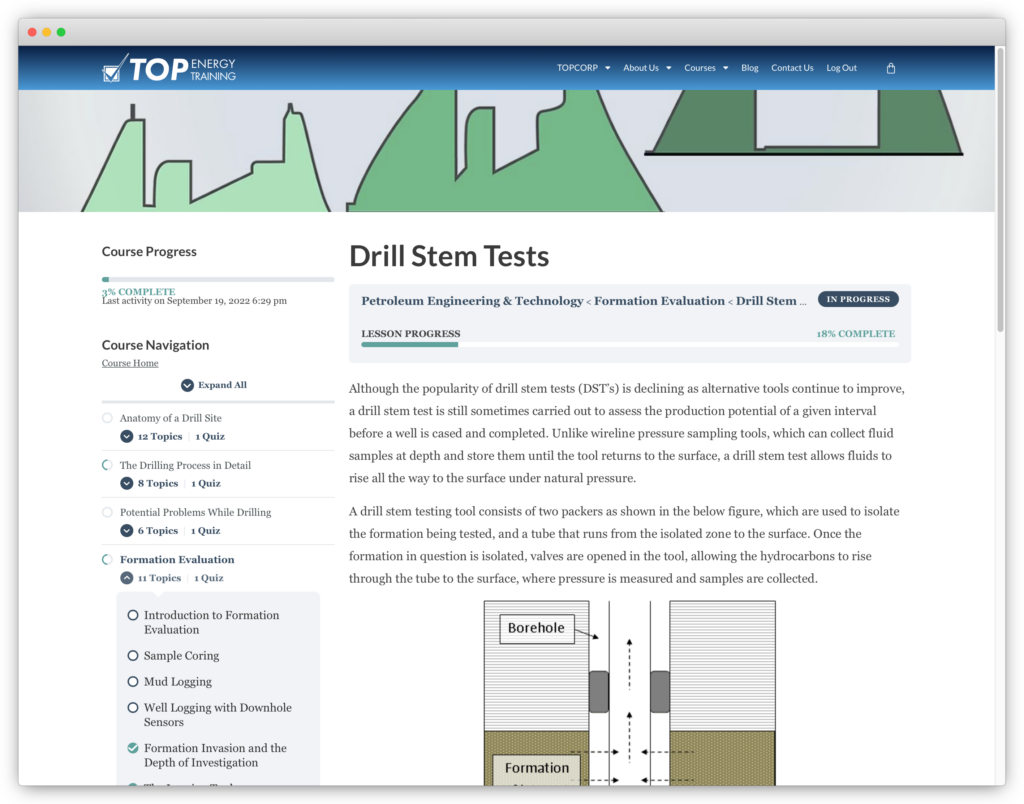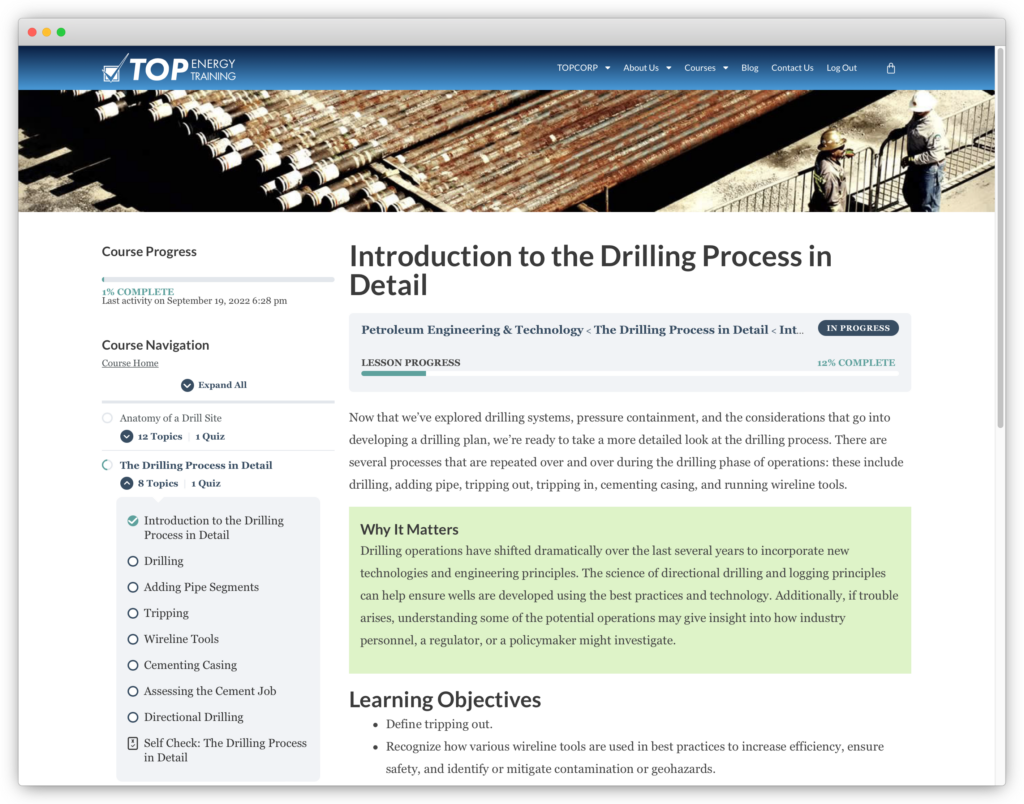Petroleum Engineering & Technology: Full Course
8 Lessons • 73 Topics
Do you have business interests in the oil and natural gas industry? Maybe you’re looking to pursue a career in the industry? If so, you could benefit from TOP Energy Training’s online oil and gas training courses. We’ve designed our courses to educate students and industry professionals on the latest technology innovations, and we review our training courses regularly to stay up-to-date with the industry. In our Petroleum Engineering & Technology Course, we cover the fundamentals of drilling and production.
Petroleum Engineering & Technology Course Content Overview
In this course, we dive into the mechanics and processes involved in drilling operations. Creating a safe, stable hole in the ground is the basic goal of the drilling process, but there are a variety of complex technologies and operational methods involved in creating that hole. In addition, this course discusses completions, formation evaluation, stimulation, production, decommissioning and reclamation.
Another key aspect of the training … [It is] focused on the science, technology, risks, and environmental issues in the oil and gas industry. This makes [for] a unique and diverse training … as it focuses on the “what” and “why” of the energy industry, leaving out the “how/policy,” making this valuable training on energy development no matter where you are from. The three universities collaborated to develop stellar tools.
—Rhonda Busch, Learning and Development Coordinator, Alberta Energy Regulator


Lessons from the course
Created in conjunction with TOP Energy Training’s highly qualified instructors, each lesson encompasses multiple topics to sharpen your knowledge and technical proficiency.

Anatomy of a Drill Site
12 Topics
Understanding the basics of drilling operations, as well as the variety of drilling components, systems, and well casing design considerations provides clarity on best practices in the oil and gas industry based on science and practical experience. In this lesson, we start by setting up the pad and rigging up the derrick and other drilling systems components. Then we talk about how all the parts of the systems work, and why operators use the equipment they do today. Next, we take a look at some of the planning that goes into selecting the proper drilling mud and casing to safely drill and isolate a well. At the end of the lesson, you will be able to recognize and identify various elements of surface and subsurface drilling rig equipment, different operations, and roles of personnel at the rig.

The Drilling Process in Detail
8 Topics
Understanding the basics of drilling operations, as well as the variety of drilling components, systems, and well casing design considerations provides clarity on best practices in the oil and gas industry based on science and practical experience. In this lesson, we start by setting up the pad and rigging up the derrick and other drilling systems components. Then we talk about how all the parts of the systems work, and why operators use the equipment they do today. Next, we take a look at some of the planning that goes into selecting the proper drilling mud and casing to safely drill and isolate a well. At the end of the lesson, you will be able to recognize and identify various elements of surface and subsurface drilling rig equipment, different operations, and roles of personnel at the rig.

Potential Problems While Drilling
6 Topics
Despite all the precautions taken by modern drillers, things can still go wrong. This lesson identifies many of the potential issues, like stuck pipe, lost circulation, wellbore instability, blowouts, and fishing, that can be encountered during drilling, and ways to avoid them. You will learn the ways a wellbore can become unstable and how to prevent this from happening, how and why lost circulation happens and how to mitigate it, ways to prevent a stuck pipe, and conditions that lead to blowouts and how to prevent them. We discuss how fishing negatively impacts progress at the well pad.

Formation Evaluation
11 Topics
The purpose of formation evaluation is to quantify the production potential of a well and make an informed decision whether it is worthwhile to complete a well, and, if so, how the well should be completed. This discipline also evaluates the potential for geologic hazards such as wellbore failure, sand production, and subsidence that might occur during the production phase of operations. The results of formation evaluation help drive the economic decisions that determine the proper well design and construction standards. In this lesson, we take a look at the tools and methods available to operators for formation evaluation. You will learn how to interpret a mud log, describe how a core sample is retrieved, recognize the importance of various sensors and tools for well log interpretation, describe a drill stem test, and understand how cores and logs are correlated.

Stimulation
16 Topics
Stimulating a well means opening up pathways around the wellbore to increase hydrocarbon fluid flow. Perhaps no aspect of oil and gas development has spurred more heated dialogue in the last 20 years than the growing utilization of multi-stage hydraulic fracturing operations for well stimulation. Decoding the actual process of well stimulation is one of the best ways to separate science from science fiction. Focusing on the science and field-based application of stimulation technologies can help identify key components of the process and how well stimulation technology is evolving. This lesson provides you with a foundation in formation damage and fractured reservoirs. Next, we walk you through the process of hydraulic fracturing and take a look at acidizing, two methods of stimulating a well.

Production
8 Topics
The production phase is the moment operators have been working towards – the moment when oil and gas begin to move out of the well and through the meters that measure the total volume sold. Often the production cycle of the well is overlooked and our attention is focused on drilling and completion. In reality, drilling and completion set the foundation for the well but they are just the beginning. The production process plays out over the entire lifetime of the well, which is measured in decades – a typical well may produce for 20, 30, 40 years, or more. There are several steps involved in formulating and implementing a production plan. And then once a well is in production, it needs to be monitored continuously. In this lesson, you will learn why “Be Prepared” might be the motto for the natural gas and oil production cycle, as well as what it takes to plan and implement production operations at both oil and gas wells. This lesson covers the stages of extraction, reservoir drive, reservoir volume estimation, artificial lift, production equipment design and installation, and enhanced recovery techniques.

Problems Encountered During Production
9 Topics
Even the best well design is not immune to human error, equipment failure, or even systemic failure of a formation. Planning ahead and identifying potential production problems early is a critical component of a sound environment, health, and safety program to everyone working on and near an operating well pad. Risks of an explosion, releases of poisonous gases, and potential groundwater contamination are examples of what must be guarded against to keep personnel and the environment safe. This lesson provides an overview of these potential production problems, including how they can be predicted, techniques for detecting problems when they occur, and potential solutions. Topics covered include fire hazards, surface spills, tank safety, hydrogen sulfide, and methane leaks, sand production, subsidence, and an overview of induced seismicity.

Decommissioning and Reclamation
3 Topics
Every well, no matter how successful, eventually reaches the point where it can no longer produce oil or gas economically. Decommissioning a well can be as important as the initial drilling and completion operations. Orphan, abandoned, and improperly plugged wells can produce a significant amount of methane directly into the atmosphere. As a conduit from the subsurface, these wells can also pose significant risks to future well drilling and completion operations, making the plugging and reclamation of oil and gas wells a final, but critical, component of the production cycle. This lesson teaches how to recognize the lifecycle of oil and gas production, what needs to be done to safely plug and abandon a well that has reached the end of its productive life, and the consequences of an improperly abandoned well.
Each lesson has a self-assessment at the end to reinforce the information and prepare you for the next lesson.
Who Should Take This Course?
Professionals working in a variety of energy-related careers (e.g., engineers, geoscientists, attorneys, accountants, managers, regulatory personnel, policymakers) know how important it is to stay current and up-to-date with the latest technology and advancements in the oil and gas sector. Students have a critical need to gain a solid foundation of industry fundamentals and distinguish their future college and/or employment applications. Educators want to present a broad perspective of the technical solutions within the oil and gas industry to their students, highlighting the diverse nature of careers and opportunities within the energy sector.

